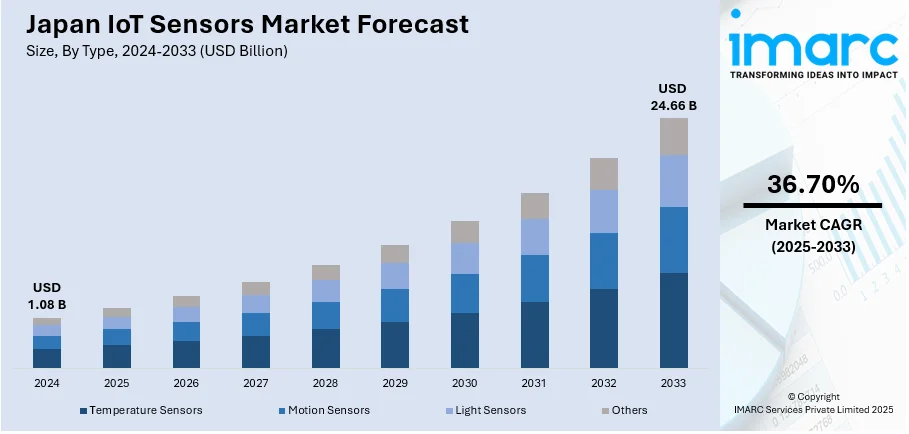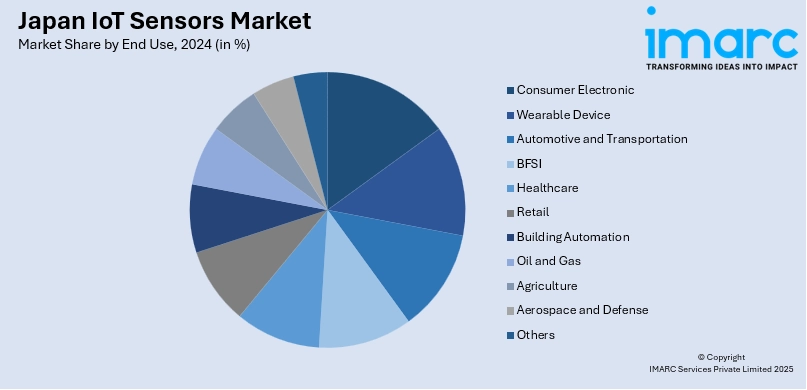
Japan IoT Sensors Market Size, Share, Trends and Forecast by Type, End Use, and Region, 2025-2033
Japan IoT Sensors Market Overview:
The Japan IoT sensors market size reached USD 1.08 Billion in 2024. Looking forward, IMARC Group expects the market to reach USD 24.66 Billion by 2033, exhibiting a growth rate (CAGR) of 36.70% during 2025-2033. The market is experiencing significant growth due to advancements in automation, smart cities, and industrial IoT applications. Key sectors, such as manufacturing, healthcare, and automotive, are also driving the demand for advanced sensor technologies. Japan's focus on innovation, government initiatives supporting digital transformation and rising adoption of IoT sensors in various industries are further contributing to the Japan IoT sensors market share.
|
Report Attribute
|
Key Statistics
|
|---|---|
|
Base Year
|
2024
|
|
Forecast Years
|
2025-2033
|
|
Historical Years
|
2019-2024
|
| Market Size in 2024 | USD 1.08 Billion |
| Market Forecast in 2033 | USD 24.66 Billion |
| Market Growth Rate 2025-2033 | 36.70% |
Japan IoT Sensors Market Trends:
Rapid Growth in Automotive Sector
Japan is a world leader in car innovation, and IoT sensors are at the forefront of changing the industry. In autonomous cars, IoT sensors provide real-time information gathering from the external environment, making cars capable of sensing obstacles, driving safely, and making decisions autonomously. IoT sensors also form the backbone of navigation systems, offering accurate data for route planning, traffic information, and GPS location accuracy. Also, the increasing trend of Vehicle-to-Everything (V2X) communication is making it possible for vehicles to communicate with other vehicles, traffic lights, and roadways, making driving safer and diminishing crashes. For instance, in October 2024, Soracom, in collaboration with Toyota, announced its plans to unveil a proof of concept for a next-gen network architecture for connected cars at the AECC International Conference in Berlin. The demonstration focuses on secure connections between vehicles and OEM clouds, enhancing automotive connectivity solutions. IoT sensors in V2X facilitate smooth data exchange, optimizing traffic movement and supporting advanced driver assistance systems (ADAS). As Japan's automotive sector speeds its transition to smart, connected, and autonomous cars, the application of IoT sensors is growing larger.

To get more information on this market, Request Sample
Healthcare Innovation
IoT sensors in Japan are revolutionizing the health sector with wearable health devices and remote health monitoring solutions. Wearables with IoT sensors monitor vital signs such as heart rate, blood pressure, and oxygen levels, and they give real-time health information to patients and healthcare professionals. IoT sensors in wearables assist with early detection of diseases, minimal frequent hospital visits, and proactive intervention, thereby driving the Japan IoT sensors market growth. For instance, in December 2024, CYBERDYNE Inc. announced certification of its Medical Vital Sensor "Cyvis" as a medical device in Japan, along with public health insurance coverage beginning January 1, 2025. The lightweight device continuously monitors cardiac activity, aiding early detection of atrial fibrillation, and will expand to gather additional health data. IoT-sensor-powered remote monitoring systems allow physicians to keep an eye on the condition of patients from afar, making healthcare more convenient, particularly for older people. The integration of these technologies is enhancing patient outcomes and lowering healthcare expenditure. The increasing focus on preventive care and the rapidly increasing elderly population are fueling the need for such technology.
Japan IoT Sensors Market Segmentation:
IMARC Group provides an analysis of the key trends in each segment of the market, along with forecasts at the country and regional levels for 2025-2033. Our report has categorized the market based on type and end use.
Type Insights:
- Temperature Sensors
- Motion Sensors
- Light Sensors
- Others
The report has provided a detailed breakup and analysis of the market based on the type. This includes temperature sensors, motion sensors, light sensors, and others.
End Use Insights:

- Consumer Electronic
- Wearable Device
- Automotive and Transportation
- BFSI
- Healthcare
- Retail
- Building Automation
- Oil and Gas
- Agriculture
- Aerospace and Defense
- Others
A detailed breakup and analysis of the market based on the end use have also been provided in the report. This includes consumer electronic, wearable device, automotive and transportation, BFSI, healthcare, retail, building automation, oil and gas, agriculture, aerospace and defense, and others.
Regional Insights:
- Kanto Region
- Kansai/Kinki Region
- Central/Chubu Region
- Kyushu-Okinawa Region
- Tohoku Region
- Chugoku Region
- Hokkaido Region
- Shikoku Region
The report has also provided a comprehensive analysis of all the major regional markets, which include Kanto Region, Kansai/Kinki Region, Central/Chubu Region, Kyushu-Okinawa Region, Tohoku Region, Chugoku Region, Hokkaido Region, and Shikoku Region.
Competitive Landscape:
The market research report has also provided a comprehensive analysis of the competitive landscape. Competitive analysis such as market structure, key player positioning, top winning strategies, competitive dashboard, and company evaluation quadrant has been covered in the report. Also, detailed profiles of all major companies have been provided.
Japan IoT Sensors Market News:
- In March 2025, Kyocera and Nitto Seimo announced their plans to launch a Smart-Sensing Research Buoy in Japan, utilizing tidal energy for continuous ocean data collection. This innovative buoy aims to enhance marine resource management and climate monitoring with cloud-based real-time insights and customizable sensor options for various applications.
- In February 2024, ABiT Corporation announced its partnership with UnaBiz to advance IoT solutions for smart cities and logistics in Japan and beyond. This partnership aims to develop Sigfox-enabled devices, leveraging UnaBiz's distribution network and ABiT's technical expertise. The new offerings are set to launch in Q4 2024 for existing customers.
Japan IoT Sensors Market Report Coverage:
| Report Features | Details |
|---|---|
| Base Year of the Analysis | 2024 |
| Historical Period | 2019-2024 |
| Forecast Period | 2025-2033 |
| Units | Billion USD |
| Scope of the Report |
Exploration of Historical Trends and Market Outlook, Industry Catalysts and Challenges, Segment-Wise Historical and Future Market Assessment:
|
| Types Covered | Temperature Sensors, Motion Sensors, Light Sensors, Others |
| End Uses Covered | Consumer Electronic, Wearable Device, Automotive and Transportation, BFSI, Healthcare, Retail, Building Automation, Oil and Gas, Agriculture, Aerospace and Defense, Others |
| Regions Covered | Kanto Region, Kansai/Kinki Region, Central/Chubu Region, Kyushu-Okinawa Region, Tohoku Region, Chugoku Region, Hokkaido Region, Shikoku Region |
| Customization Scope | 10% Free Customization |
| Post-Sale Analyst Support | 10-12 Weeks |
| Delivery Format | PDF and Excel through Email (We can also provide the editable version of the report in PPT/Word format on special request) |
Key Questions Answered in This Report:
- How has the Japan IoT sensors market performed so far and how will it perform in the coming years?
- What is the breakup of the Japan IoT sensors market on the basis of type?
- What is the breakup of the Japan IoT sensors market on the basis of end use?
- What is the breakup of the Japan IoT sensors market on the basis of region?
- What are the various stages in the value chain of the Japan IoT sensors market?
- What are the key driving factors and challenges in the Japan IoT sensors market?
- What is the structure of the Japan IoT sensors market and who are the key players?
- What is the degree of competition in the Japan IoT sensors market?
Key Benefits for Stakeholders:
- IMARC’s industry report offers a comprehensive quantitative analysis of various market segments, historical and current market trends, market forecasts, and dynamics of the Japan IoT sensors market from 2019-2033.
- The research report provides the latest information on the market drivers, challenges, and opportunities in the Japan IoT sensors market.
- Porter's five forces analysis assist stakeholders in assessing the impact of new entrants, competitive rivalry, supplier power, buyer power, and the threat of substitution. It helps stakeholders to analyze the level of competition within the Japan IoT sensors industry and its attractiveness.
- Competitive landscape allows stakeholders to understand their competitive environment and provides an insight into the current positions of key players in the market.
Need more help?
- Speak to our experienced analysts for insights on the current market scenarios.
- Include additional segments and countries to customize the report as per your requirement.
- Gain an unparalleled competitive advantage in your domain by understanding how to utilize the report and positively impacting your operations and revenue.
- For further assistance, please connect with our analysts.
 Request Customization
Request Customization
 Speak to an Analyst
Speak to an Analyst
 Request Brochure
Request Brochure
 Inquire Before Buying
Inquire Before Buying




.webp)




.webp)












